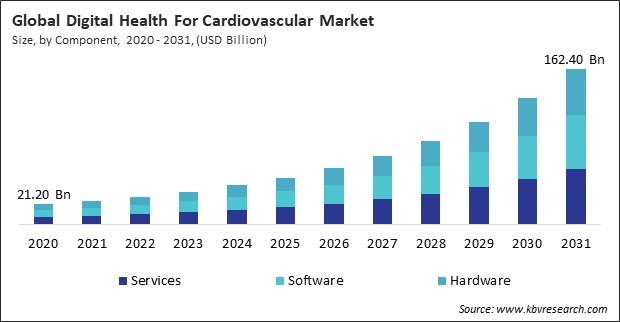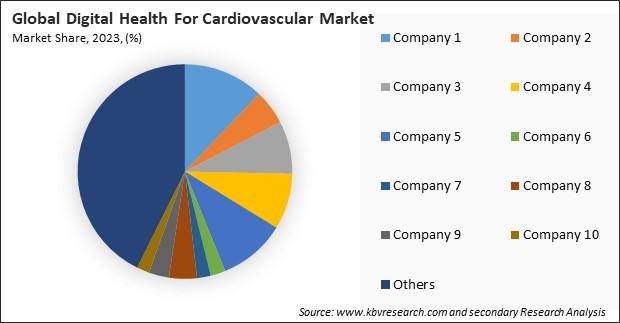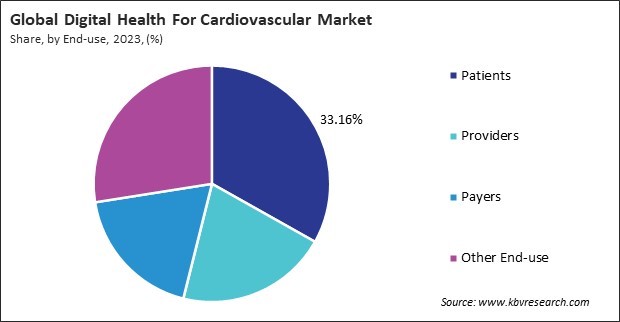“Global Digital Health For Cardiovascular Market to reach a market value of USD 162.40 Billion by 2031 growing at a CAGR of 21.9%”
The Global Digital Health For Cardiovascular Market size is expected to reach $162.40 billion by 2031, rising at a market growth of 21.9% CAGR during the forecast period.
The North America segment witnessed 37% revenue share in the market in 2023. The region benefits from the widespread use of remote patient monitoring (RPM) devices, telemedicine platforms, and wearable health technologies like the Apple Watch and KardiaMobile, which are FDA-cleared for detecting cardiovascular conditions such as atrial fibrillation.

The global prevalence of cardiovascular diseases (CVDs) has been rising at an alarming rate, making them the leading cause of death worldwide. In 2019, the World Health Organization (WHO) estimated that 17.9 million individuals perished from cardiovascular diseases (CVDs), which accounted for 32% of all global deaths. Heart attacks and strokes were responsible for 85% of these fatalities. Hence, the rising prevalence of cardiovascular diseases globally drives demand for digital health solutions.
Additionally, Wearable devices such as smartwatches, fitness trackers, and wearable ECG monitors have grown significantly over the past decade, emerging as vital tools in proactive cardiovascular care. One of the standout examples of wearables transforming heart health is their ability to detect atrial fibrillation (AFib). AFib is a cardiac rhythm that is irregular and frequently rapid, and it can result in heart failure, stroke, blood clots, and other heart-related complications. Thus, as technology advances, these devices are expected to become an even more integral part of preventive cardiology and chronic disease management.
Moreover, The COVID-19 pandemic initially posed several challenges to the digital health for cardiovascular market. In the early stages, healthcare systems worldwide were overwhelmed by COVID-19 cases, diverting attention and resources from non-emergency cardiovascular care. Elective procedures and routine check-ups for heart patients were often delayed or canceled, disrupting the standard treatment and monitoring processes. Thus, the pandemic had an overall positive impact on the market.
However, Many healthcare providers and patients are unable to access devices such as wearable cardiac monitors, AI-powered diagnostics, and remote patient monitoring systems due to their substantial cost. These technologies often require continuous updates, software integrations, and cloud storage, increasing operational expenses. Additionally, setting up telemedicine infrastructure and maintaining digital platforms for cardiovascular patients demands investment in cybersecurity, compliance with regulations, and staff training, which can financially overwhelm healthcare institutions. Hence, without strategic interventions, the high cost of digital health tools will continue to be a significant hurdle in transforming cardiovascular healthcare through digitalization.

The leading players in the market are competing with diverse innovative offerings to remain competitive in the market. The above illustration shows the percentage of revenue shared by some of the leading companies in the market. The leading players of the market are adopting various strategies in order to cater demand coming from the different industries. The key developmental strategies in the market are Acquisitions, and Partnerships & Collaborations.
On the basis of end-use, the market is divided into patients, providers, payers, and others. The providers segment recorded 21% revenue share in the market in 2023. Hospitals, clinics, and cardiac centers are increasingly adopting digital health tools such as telemedicine platforms, remote patient monitoring systems, and AI-powered diagnostic solutions to provide timely and accurate cardiovascular care.

Based on component, the market is classified into software, hardware, and services. The hardware segment procured 29% revenue share in the market in 2023. The demand for devices such as ECG monitors, smartwatches with heart rate sensors, and implantable cardiac devices has increased as a result of the increasing prevalence of heart diseases as well as the growing emphasis on preventive care.
Free Valuable Insights: Global Digital Health For Cardiovascular Market size to reach USD 162.40 Billion by 2031
Region-wise, the market is analyzed across North America, Europe, Asia Pacific, and LAMEA. The Asia Pacific segment garnered 24% revenue share in the market in 2023. Rapid urbanization, changing dietary habits, sedentary lifestyles, and high rates of hypertension and diabetes have increased the demand for digital health solutions targeting heart disease prevention and management.
| Report Attribute | Details |
|---|---|
| Market size value in 2023 | USD 33.95 Billion |
| Market size forecast in 2031 | USD 162.40 Billion |
| Base Year | 2023 |
| Historical Period | 2020 to 2022 |
| Forecast Period | 2024 to 2031 |
| Revenue Growth Rate | CAGR of 21.9% from 2024 to 2031 |
| Number of Pages | 182 |
| Number of Tables | 270 |
| Report coverage | Market Trends, Revenue Estimation and Forecast, Segmentation Analysis, Regional and Country Breakdown, Market Share Analysis, Porter’s 5 Forces Analysis, Company Profiling, Companies Strategic Developments, SWOT Analysis, Winning Imperatives |
| Segments covered | Component, End-use, Region |
| Country scope |
|
| Companies Included | Apple, Inc., Orange S.A., Epic Systems Corporation, Siemens Healthineers AG (Siemens AG), GE HealthCare Technologies, Inc.. CardiAI.Inc, Vista.ai (HeartVista, Inc.), Viz.ai, Inc., Cleerly, Inc., and RSIP Vision Ltd. |
By Component
By End-use
By Geography
This Market size is expected to reach $162.40 billion by 2031.
Rising Prevalence of Cardiovascular Diseases (CVDs) are driving the Market in coming years, however, High Cost of Advanced Digital Health Tools restraints the growth of the Market.
Apple, Inc., Orange S.A., Epic Systems Corporation, Siemens Healthineers AG (Siemens AG), GE HealthCare Technologies, Inc.. CardiAI.Inc, Vista.ai (HeartVista, Inc.), Viz.ai, Inc., Cleerly, Inc., and RSIP Vision Ltd.
The expected CAGR of this Market is 21.9% from 2023 to 2031.
The Services segment led the maximum revenue in the Market by Component in 2023, thereby, achieving a market value of $58.10 Billion by 2031.
The North America region dominated the Market by Region in 2023, thereby, achieving a market value of $58.08 Billion by 2031.
Our team of dedicated experts can provide you with attractive expansion opportunities for your business.

 Drivers
Drivers
 Restraints
Restraints
 Opportunities
Opportunities
 Challenges
Challenges
